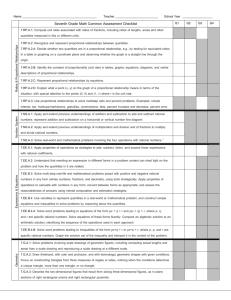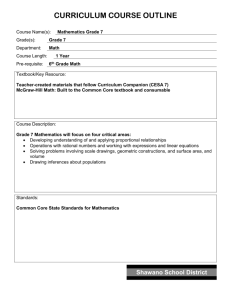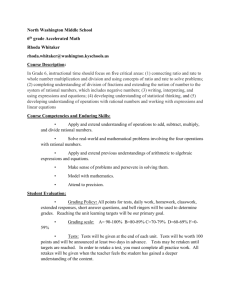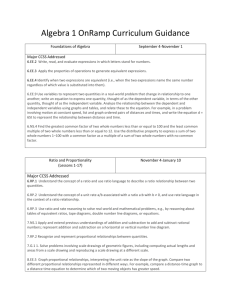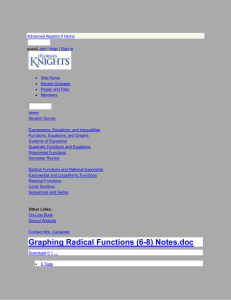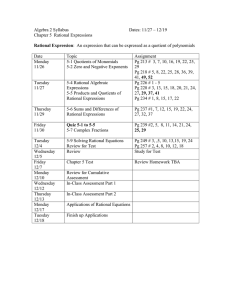Seventh Grade
advertisement
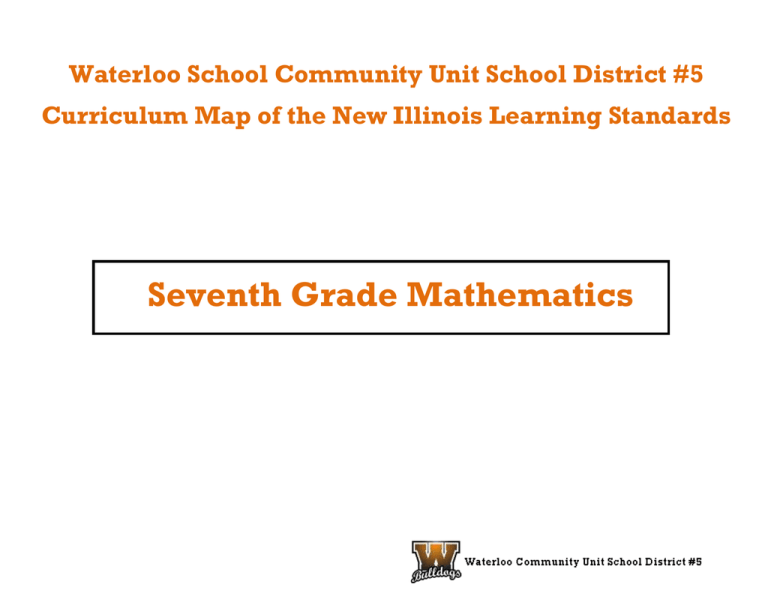
Waterloo School Community Unit School District #5 Curriculum Map of the New Illinois Learning Standards Seventh Grade Mathematics How to Read the Grade Level Content Standards Standards define what students should understand and be able to do. Clusters are groups of related standards. Note that standards from different clusters may sometimes be closely related, because mathematics is a connected subject. Domains are larger groups of related standards. Standards from different domains may sometimes be closely related. 1 Standards for Mathematical Practice The Common Core State Standards for Mathematical Practice are expected to be integrated into every mathematics lesson for all students Grades K-12. Below are a few examples of how these Practices may be integrated into tasks students complete. 1. Make sense of problems and persevere in solving them. In grade 7, students solve problems involving ratios and rates and discuss how they solved the problems. Students solve real world problems through the application of algebraic and geometric concepts. Students seek the meaning of a problem and look for efficient ways to represent and solve it. They may check their thinking by asking themselves, “What is the most efficient way to solve the problem?”, “Does this make sense?”, and “Can I solve the problem in a different way?”. 2. Reason abstractly and quantitatively. In grade 7, students represent a wide variety of real world contexts through the use of real numbers and variables in mathematical expressions, equations, and inequalities. Students contextualize to understand the meaning of the number or variable as related to the problem and decontextualize to manipulate symbolic representations by applying properties of operations. 3. Construct viable arguments and critique the reasoning of others. In grade 7, students construct arguments using verbal or written explanations accompanied by expressions, equations, inequalities, models, and graphs, tables, and other data displays (i.e. box plots, dot plots, histograms, etc.). The students further refine their mathematical communication skills through mathematical discussions in which they critically evaluate their own thinking and the thinking of other students. They pose questions like “How did you get that?”, “Why is that true?”, “Does that always work?”. They explain their thinking to others and respond to others’ thinking. 4. Model with mathematics. In grade 7, students model problem situations symbolically, graphically, tabularly, and contextually. Students form expressions, equations, or inequalities from real world contexts and connect symbolic and graphical representations. Students explore covariance and represent two quantities simultaneously. They use measures of center and variability and data displays (i.e. box plots and histograms) to draw inferences, make comparisons and formulate predictions. Students use experiments or simulations to generate data sets and create probability models. Students need many opportunities to connect and explain the connections between the different representations. They should be able to use all of these representations as appropriate to any problem’s context. 2 5. Use appropriate tools strategically. Students consider available tools (including estimation and technology) when solving a mathematical problem and decide when certain tools might be helpful. For instance, students in grade 7 may decide to represent similar data sets using dot plots with the same scale to visually compare the center and variability of the data. Students might use physical objects or applets to generate probability data and use graphing calculators or spreadsheets to manage and represent data in different forms. 6. Attend to precision. In grade 7, students continue to refine their mathematical communication skills by using clear and precise language in their discussions with others and in their own reasoning. Students define variables, specify units of measure, and label axes accurately. Students use appropriate terminology when referring to rates, ratios, probability models, geometric figures, data displays, and components of expressions, equations or inequalities. 7. Look for and make use of structure. Students routinely seek patterns or structures to model and solve problems. For instance, students recognize patterns that exist in ratio tables making connections between the constant of proportionality in a table with the slope of a graph. Students apply properties to generate equivalent expressions (i.e. 6 + 2x = 3 (2 + x) by distributive property) and solve equations (i.e. 2c + 3 = 15, 2c = 12 by subtraction property of equality), c = 6 by division property of equality). Students compose and decompose two- and three-dimensional figures to solve real world problems involving scale drawings, surface area, and volume. Students examine tree diagrams or systematic lists to determine the sample space for compound events and verify that they have listed all possibilities. 8. Look for and express regularity in repeated reasoning. In grade 7, students use repeated reasoning to understand algorithms and make generalizations about patterns. During multiple opportunities to solve and model problems, they may notice that a/b ÷ c/d = ad/bc and construct other examples and models that confirm their generalization. They extend their thinking to include complex fractions and rational numbers. Students formally begin to make connections between covariance, rates, and representations showing the relationships between quantities. They create, explain, evaluate, and modify probability models to describe simple and compound events. 3 Seventh Grade Mathematics Curriculum Waterloo School District Scope and Sequence Overview Unit of Study Transition Math Alignment 1 Chapters 1 & 2 2 Chapter 3 3 Chapter 5 4 Chapter 6 5 Chapter 7 6 Chapter 8 7 Chapter 9 8 Chapter 12 9 Chapter 11 Domain and Standards Domain: Statistics and Probability Standards: 7.SP.5, 7.SP.6, 7.SP.7a, 7.SP.7b Domains: Expressions & Equations, The Number System, Geometry, Statistics & Probability Standards: 7.EE.1, 7.EE.2, 7.EE.3, 7.EE.4, 7.NS.1a, 7.NS.1b, 7.NS.1c, 7.NS.1d, 7.NS.3. 7.G.2, 7.SP.7, 7.SP.8, 7.SP.8a, 7.SP.8b Domains: Geometry, Expressions and Equations Standards: 7.G.1, 7.G.5, 7.EE.1, 7.EE.2, 7.EE.4, 7.EE.4a Domains: Expressions & Equations, The Number System, Geometry Standards: 7.G.1, 7.G.6, 7.NS.2, 7.NS.2a, 7.EE.1 Domains: The Number System, Expressions & Equations, Ratios and Proportional Relationships, Statistics and Probability Standards: 7.NS.2a, 7.NS.2c, 7.NS.3, 7.EE.1, 7.EE.2, 7.EE.4a, 7.RP.1, 7.RP.2, 7.RP.3, 7.SP.7a, 7.SP.8a, 7.SP.8c Domains: The Number System, Expressions & Equations, Geometry, Ratios and Proportional Relationships Standards: 7.NS.2, 7.NS.2a, 7.NS.2b, 7.NS.2c, 7.NS.3, 7.EE.3, 7.EE.4, 7.EE.4a, 7.EE.4B, 7.G.1, 7.RP.1, 7.RP.2, 7.RP.2a, 7.RP.2b, 7.RP.2c, 7.RP.2d, 7.RP.3 Domain: Statistics and Probability Standards: 7.SP.1, 7.SP.2, 7.SP.3, 7.SP.4 Domain: Geometry Standards: 7.G.3, 7.G.4, 7.G.6 4 Seventh Grade Instruction and Assessment Schedule Ch. 1/2 Test Ch. 3 Test Unit of Study 3 Unit of Study 4 Ch. 5 Test Ch. 6 Test 18 26 Unit of Study 5 Unit of Study 6 Ch. 7 Test Ch. 8 Test 19 16 13 Unit of Study 7 Unit of Study 8 Unit of Study 9 Ch. 9 Test Ch. 12 Test Ch. 11 Quiz End of Year Benchmark 3 Unit of Study 2 18 Common Assessment D Unit of Study 1 25 Benchmark 2 11 Common Assessment C Assessment 16 Common Assessment B Instructional Content Benchmark 1 Approx. Number of Days of Instruction Common Assessment A It is expected that the units will be taught consecutively. The table below reflects which units are assessed on each benchmark. It is possible to begin a new unit prior to the quarter in which it is being assessed. 5 Unit of Study 1: Chapters 1 & 2 Seventh Grade Math Content Objectives I can use a variable to represent an unknown quantity Quarter 1 Vocabulary Approx. 16 days Teacher’s Resources and Notes Positive/negative integers Inequality Double inequality Base Exponent Power Exponential form Scientific notation Square Square root Radical sign X & y coordinates X & y axes Origin Quadrants Algebraic expression Right triangle Hypotenuse Pythagorean Theorem 6 Transitions Math Common Core Alignment 1-2 Unit of Study 1 – Additional Resources Triangle Tables Task - 7.EE.2 – Students figure out how many people can sit around different numbers of triangular tables when put together. 1-4 1-5 1-6 1-7 1-8 1-9 2-2 2-5 2-8 7 Unit of Study 2: Chapter 3 Seventh Grade Quarter 1 Approx. 11 days Domain: Statistics and Probability Standard(s): 7.SP.5 Understand that the probability of a chance event is a number between 0 and 1 that expresses the likelihood of the event occurring. Larger numbers indicate greater likelihood. A probability near 0 indicates an unlikely event, a probability around 1/2 indicates an event that is neither unlikely nor likely, and a probability near 1 indicates a likely event. 7.SP.6 Approximate the probability of a chance event by collecting data on the chance process that produces it and observing its long-run relative frequency, and predict the approximate relative frequency given the probability. For example, when rolling a number cube 600 times, predict that a 3 or 6 would be rolled roughly 200 times, but probably not exactly 200 times. 7.SP.7a Develop a uniform probability model by assigning equal probability to all outcomes, and use the model to determine probabilities of events. For example, if a student is selected at random from a class, find the probability that Jane will be selected and the probability that a girl will be selected. 7.SP.7b Develop a probability model (which may not be uniform) by observing frequencies in data generated from a chance process. For example, find the approximate probability that a spinning penny will land heads up or that a tossed paper cup will land open-end down. Do the outcomes for the spinning penny appear to be equally likely based on the observed frequencies? 8 Math Content Objectives 7.SP.5 I can define probability as a ratio that compares favorable outcomes to all possible outcomes. I can recognize and explain that probabilities are expressed as a number between zero to one. I can interpret a probability near zero is unlikely to occur and a probability near one as likely to occur. I can interpret a probability near one-half as being as equally to occur as to not occur. Vocabulary Teacher’s Resources and Notes Interval Frequency Relative frequency Probability Random Event 7.SP.6 I can collect data on a chance process to approximate its probability. I can use probability to predict the number of times a particular event will occur given a specific number of trials. 7.SP.7a I can determine the probability of the event from the simulation model 7.SP.7b I can conduct a probability experiment and develop a theoretical probability model to represent the situation 9 Transitions Math Common Core Alignment Unit of Study 2 – Additional Resources 3-1 3-2 3-3 3-6 3-9 7.SP.5 7.SP.6 7.SP.7 7.SP.7a 7.SP.7b 10 Unit of Study 3: Chapter 5 Seventh Grade Quarters 1/2 Approx. 25 days Domain: Expressions & Equations Standard(s): 7.EE.1 Apply properties of operations as strategies to add, subtract, factor, and expand linear expressions with rational coefficients. 7.EE.2 Understand that rewriting an expression in different forms in a problem context can shed light on the problem and how the quantities in it are related. For example, a + 0.05a = 1.05a means that “increase by 5%” is the same as “multiply by 1.05.” 7.EE.3 Solve multi-step real-life and mathematical problems posed with positive and negative rational numbers in any form (whole numbers, fractions, and decimals), using tools strategically. Apply properties of operations to calculate with numbers in any form; convert between forms as appropriate; and assess the reasonableness of answers using mental computation and estimation strategies. For example: If a woman making $25 an hour gets a 10% raise, she will make an additional 1/10 of her salary an hour, or $2.50, for a new salary of $27.50. If you want to place a towel bar 9 3/4 inches long in the center of a door that is 27 1/2 inches wide, you will need to place the bar about 9 inches from each edge; this estimate can be used as a check on the exact computation. 7.EE.4 Use variables to represent quantities in a real-world or mathematical problem, and construct simple equations and inequalities to solve problems by reasoning about the quantities. Domain: The Number System Standard(s): 7.NS.1a Describe situations in which opposite quantities combine to make 0. For example, a hydrogen atom has 0 charge because its two constituents are oppositely charged. 7.NS.1b Understand p + q as the number located a distance |q| from p, in the positive or negative direction depending on whether q is positive or negative. Show that a number and its opposite have a sum of 0 (are additive inverses). Interpret sums of rational numbers by describing real-world contexts. 7.NS.1c Understand subtraction of rational numbers as adding the additive inverse, p – q = p + (–q). Show that the distance between two rational numbers on the number line is the absolute value of their difference, and apply this principle in real-world contexts. 7.NS.1d Apply properties of operations as strategies to add and subtract rational numbers. 7.NS.3 Solve real-world and mathematical problems involving the four operations with rational numbers. Domain: Geometry Standard(s): 7.G.2 Draw (freehand, with ruler and protractor, and with technology) geometric shapes with given conditions. Focus on constructing triangles from three measures of angles or sides, noticing when the conditions determine a unique triangle, more than one triangle, or no triangle. 11 Domain: Statistics & Probability Standard(s): 7.SP.7 Develop a probability model and use it to find probabilities of events. Compare probabilities from a model to observed frequencies; if the agreement is not good, explain possible sources of the discrepancy. 7.SP.8 Find probabilities of compound events using organized lists, tables, tree diagrams, and simulation. 7.SP.8a Understand that, just as with simple events, the probability of a compound event is the fraction of outcomes in the sample space for which the compound event occurs. 7.SP.8b Represent sample spaces for compound events using methods such as organized lists, tables and tree diagrams. For an event described in everyday language (e.g., “rolling double sixes”), identify the outcomes in the sample space which compose the event. 12 Math Content Objectives 7.EE.1 I can apply the properties of operations as strategies to add, subtract, factor, and expand linear expressions with rational coefficients. 7.EE.2 I can use equivalent expressions to understand the relationships between quantities. Vocabulary Absolute Value Fact Triangle Related Facts Equations Complement Arc Teacher’s Resources and Notes Probability Task (project 3/4) – 7.SP.5; 7.SP.7; 7.SP.7a; 7.SP.8 7.EE.3 I can solve real world problems using rational numbers in any form, including those problems involving multiple steps. I can use properties of operations to fluently compute with rational numbers. 7.EE.4 I can use a variable to represent an unknown quantity. 7.NS.1a I can describe real-world situations where opposite quantities have a sum of zero. 7.NS.1b I can describe real world situations represented by the subtraction of integers. I can interpret the addition of integers by relating the values to real world situations. 7.NS.1c I can rewrite a subtraction problem as an addition problem by using the additive inverse. 7.NS.1d I can use the properties of operations to add and subtract rational numbers 13 Math Content Objectives (continued) Vocabulary Teacher’s Resources and Notes 7.NS.3 I can solve real world problems that involve the addition, subtraction, multiplication, and division of rational numbers 7.G.2 I can construct a triangle when given three measurements: 3 side lengths. I can determine when 3 specific measurements will result in one unique triangle, more than one possible triangle, or no possible triangles. 7.SP.7 I can determine the probability of the event from the simulation model I can conduct a probability experiment and develop a theoretical probability model to represent the situation 7.SP.8 I can create a sample space of all possible outcomes for a compound event by using an organized list, a table, or a tree diagram. I can use the sample space to compare the number of favorable outcomes to the total number of outcomes 7.SP.8a I can extend the principles of probability from simple events to compound events 7.SP.8b I can represent sample spaces for compound events using multiple methods I can find the probability of compound events based on the sample space 14 Transitions Math Common Core Alignment 5-7 7.EE.1 Unit of Study 3 – Additional Resources Probability Task – 7.SP.7, 7.SP.8, 7.SP.8a, 7.SP.8b 5-8 7.SP.7 7.SP.8 7.SP.8a 7.SP.8b 5-9 7.G.2 5-10 7.EE.4b 15 Unit of Study 4: Chapter 6 Seventh Grade Quarter 2 Approx. 18 days Domain: Geometry Standard(s): 7.G.1 Solve problems involving scale drawings of geometric figures, including computing actual lengths and areas from a scale drawing and reproducing a scale drawing at a different scale. 7.G.5 Use facts about supplementary, complementary, vertical, and adjacent angles in a multi-step problem to write and solve simple equations for an unknown angle in a figure. Domain: Expressions & Equations Standard(s): 7.EE.1 Apply properties of operations as strategies to add, subtract, factor, and expand linear expressions with rational coefficients. 7.EE.2 Understand that rewriting an expression in different forms in a problem context can shed light on the problem and how the quantities in it are related. For example, a + 0.05a = 1.05a means that “increase by 5%” is the same as “multiply by 1.05.” 7.EE.4 Use variables to represent quantities in a real-world or mathematical problem, and construct simple equations and inequalities to solve problems by reasoning about the quantities. 7.EE.4a Solve word problems leading to equations of the form px + q = r and p(x + q) = r, where p, q, and r are specific rational numbers. Solve equations of these forms fluently. Compare an algebraic solution to an arithmetic solution, identifying the sequence of the operations used in each approach. For example, the perimeter of a rectangle is 54 cm. Its length is 6 cm. What is its width? 16 Math Content Objectives 7.G.1 I can use a scale drawing to determine the actual dimensions of a geometric figure. Use a different scale to reproduce a similar scale drawing. 7.G.5 I can state the relationship between supplementary angles, vertical angles, linear pairs, alternate interior angles, alternate exterior angles, same-side interior angles, same-side exterior angles, and corresponding angles. I can use angle relationships to write algebraic equations for unknown angles. Can use angle relationships to solve multi-step problems. Vocabulary Teacher’s Resources and Notes Scale Drawing Scale Factor Scale Supplementary Angles Vertical Angles Linear Pairs Alternate Interior Angles Alternate Exterior Angles Same-side Interior Same-side Exterior Corresponding Angles Rhombus Consecutive Angles 7.EE.1 I can apply the properties of operations as strategies to add, subtract, factor, and expand linear expressions with rational coefficients. 7.EE.2 I can use equivalent expressions to understand the relationships between quantities. 7.EE.4 I can use a variable to represent an unknown quantity. 7.EE.4a I can use inverse operations and the properties of equality to solve real-world problems leading to equations 17 Transitions Math Common Core Alignment 6-5 7.G.5 6-6 7.G.5 Unit of Study 4 – Additional Resources Scale Drawing Task – 7.G.1 – Students watch a video on how to find the scale factor. They then use this knowledge to take a small picture and enlarge it to a given size. Patterns Task – 7.EE.1; 7.EE.2 - developing a pattern and equation from a given set of pictures; rewriting the equation in different forms 6-7 7.G.5 6-8 7.G.5 6-9 7.EE.4 7.EE.4a 18 Unit of Study 5: Chapter 7 Seventh Grade Quarter 3 Approx. 18 days Domain: 7.G - Geometry Standard(s): 7.G.4 Know the formulas for the area and circumference of a circle and use them to solve problems; give an informal derivation of the relationship between the circumference and area of a circle. 7.G.6 Solve real-world and mathematical problems involving area, volume and surface area of two- and three-dimensional objects composed of triangles, quadrilaterals, polygons, cubes, and right prisms. Domain: 7.NS – Number System Standard(s): 7.NS.2 Apply and extend previous understandings of multiplication and division and of fractions to multiply and divide rational numbers. 7.NS.2a Understand that multiplication is extended from fractions to rational numbers by requiring that operations continue to satisfy the properties of operations, particularly the distributive property, leading to products such as (–1)(–1) = 1 and the rules for multiplying signed numbers. Interpret products of rational numbers by describing real-world contexts. Domain: 7.EE – Expressions & Equations Standard(s): 7.EE.1 Apply properties of operations as strategies to add, subtract, factor, and expand linear expressions with rational coefficients. 19 Math Content Objectives 7.G.4 I can state the formula and determine the circumference of a circle. I can determine the diameter or radius of a circle when the circumference is given. 7.G.6 I can state the formula and determine the area of 2-dimensional figures including circles, triangles, parallelograms and trapezoids. I can solve real-world problems involving area. Vocabulary Teacher’s Resources and Notes Reciprocal Distributive Property Altitude Radius Diameter Sector Arc Circumference Area Trapezoid 7.NS.2 I can generalize the procedures for multiplying and dividing integers to all rational numbers 7.NS.2a I can use the rules for multiplying signed numbers to determine the sign of the product I can interpret products of rational numbers by describing real world situations 7.EE.1 I can use the commutative, associative, and distributive properties. 20 Transitions Math Common Core Alignment 7-1 7.G.6 7.NS.2 Unit of Study 5 – Additional Resources Distributive Property iPad Activity – discovering distributive property through repeated addition 7-2 7.NS.2 7.NS.2a 7-3 7.EE.1 7-4 7.G.6 7-5 7.G.6 7-6 7.G.4 21 Unit of Study 6: Chapter 8 Seventh Grade Quarter 3 Approx. 26 days Domain: 7.NS – The Number System Standard(s): 7.NS.2a Understand that multiplication is extended from fractions to rational numbers by requiring that operations continue to satisfy the properties of operations, particularly the distributive property, leading to products such as (–1)(–1) = 1 and the rules for multiplying signed numbers. Interpret products of rational numbers by describing real-world contexts. 7.NS.2c Apply properties of operations as strategies to multiply and divide rational numbers. 7.NS.3 Solve real-world and mathematical problems involving the four operations with rational numbers. Domain: 7.EE – Expressions & Equations Standard(s): 7.EE.1 Apply properties of operations as strategies to add, subtract, factor, and expand linear expressions with rational coefficients. 7.EE.2 Understand that rewriting an expression in different forms in a problem context can shed light on the problem and how the quantities in it are related. For example, a + 0.05a = 1.05a means that “increase by 5%” is the same as “multiply by 1.05.” 7.EE.4a Solve word problems leading to equations of the form px + q = r and p(x + q) = r, where p, q, and r are specific rational numbers. Solve equations of these forms fluently. Compare an algebraic solution to an arithmetic solution, identifying the sequence of the operations used in each approach. For example, the perimeter of a rectangle is 54 cm. Its length is 6 cm. What is its width? Domain: 7.RP – Ratios & Proportional Relationships Standard(s): 7.RP.1 Compute unit rates associated with ratios of fractions, including ratios of lengths, areas and other quantities measured in like or different units. For example, if a person walks 1/2 mile in each 1/4 hour, compute the unit rate as the complex fraction 1/2/1/4 miles per hour, equivalently 2 miles per hour. 7.RP.2 Recognize and represent proportional relationships between quantities. 7.RP.3 Use proportional relationships to solve multistep ratio and percent problems. Examples: simple interest, tax, markups and markdowns, gratuities and commissions, fees, percent increase and decrease, percent error. 22 Domain: 7.SP – Statistics & Probability Standard(s): 7.SP.7a Develop a uniform probability model by assigning equal probability to all outcomes, and use the model to determine probabilities of events. For example, if a student is selected at random from a class, find the probability that Jane will be selected and the probability that a girl will be selected. 7.SP.8a Understand that, just as with simple events, the probability of a compound event is the fraction of outcomes in the sample space for which the compound event occurs. 7.SP.8c Design and use a simulation to generate frequencies for compound events. For example, use random digits as a simulation tool to approximate the answer to the question: If 40% of donors have type A blood, what is the probability that it will take at least 4 donors to find one with type A blood? 23 Math Content Objectives 7.NS.2a I can use the rules for multiplying signed numbers to determine the sign of the product I can interpret products of rational numbers by describing real world situations 7.NS.2c I can multiply and divide rational numbers using the properties of operations Vocabulary Teacher’s Resources and Notes Coefficients Like Terms Rate Conversion Factor Independent Events Dependent Events 7.NS.3 I can use the order of operations to solve mathematical and real-world problems with rational numbers 7.EE.1 I can combine like terms. 7.EE.2 I can manipulate expressions to make equivalent expressions while problem solving. 7.EE. 4a I can use a variable to represent an unknown quantity I can write a simple algebraic equation in the form px+q=r I can use inverse operations and properties of equality to solve equations 7.RP.1 I can compute a unit rate by using multiplicative comparisons. 7.RP.2 I can use words to explain the relevance of a specific point on the graph of a proportional relationship including, but not limited to, the ordered pair (0,0) or (1,r) 7.RP.3 I can use proportional reasoning to solve real-world ratio and percent problems including those with multiple steps. I can use proportional relationships to solve multi-step percent problems. 24 Math Content Objectives Vocabulary Teacher’s Resources and Notes 7.SP.7 I can develop a simulation to model a situation in which all events are equally likely to occur I can utilize the simulation to determine the probability of specific events I can determine the probability of events that may not be equally likely to occur, by utilizing a simulation model 7.SP.8a I can extend the principles of probability of simple events to compound events I can find the probability of compound events based on the simulation 25 37.N Transitions Math Common Core Alignment Unit of Study 6 – Additional Resources 8-1 7.NS.3 7.EE.1 7.EE.2 7.NS.2 7.NS.2a 8-2 7.RP.1 7.NS.2 7.NS.2a 7.NS.3 8-3 7.NS.2 7.NS.2a 7.NS.3 8-4 7.SP.7a 7.SP.8 7.SP.8a 7.SP.8c 8-5 7.EE.2 7.RP.3 8-6 7.EE.4 7.NS.2c 8-7 7.RP.2 8-8 7.EE.4 7.EE.4a 8-9 7.EE.4 7.EE.4b 26 Unit of Study 7: Chapter 9 Seventh Grade Quarter 4 Approx. 19 days Domain: The Number System Standard(s): 7.NS.2 Apply and extend previous understandings of multiplication and division and of fractions to multiply and divide rational numbers. 7.NS.2a Understand that multiplication is extended from fractions to rational numbers by requiring that operations continue to satisfy the properties of operations, particularly the distributive property, leading to products such as (–1)(–1) = 1 and the rules for multiplying signed numbers. Interpret products of rational numbers by describing real-world contexts. 7.NS.2b Understand that integers can be divided, provided that the divisor is not zero, and every quotient of integers (with non-zero divisor) is a rational number. If p and q are integers, then –(p/q) = (–p)/q = p/(–q). Interpret quotients of rational numbers by describing real-world contexts. 7.NS.2c Apply properties of operations as strategies to multiply and divide rational numbers. 7.NS.3 Solve real-world and mathematical problems involving the four operations with rational numbers. Domain: Expressions & Equations Standard(s): 7.EE.3 Solve multi-step real-life and mathematical problems posed with positive and negative rational numbers in any form (whole numbers, fractions, and decimals), using tools strategically. Apply properties of operations to calculate with numbers in any form; convert between forms as appropriate; and assess the reasonableness of answers using mental computation and estimation strategies. For example: If a woman making $25 an hour gets a 10% raise, she will make an additional 1/10 of her salary an hour, or $2.50, for a new salary of $27.50. If you want to place a towel bar 9 3/4 inches long in the center of a door that is 27 1/2 inches wide, you will need to place the bar about 9 inches from each edge; this estimate can be used as a check on the exact computation. 7.EE.4 Use variables to represent quantities in a real-world or mathematical problem, and construct simple equations and inequalities to solve problems by reasoning about the quantities. 7.EE.4a Solve word problems leading to equations of the form px + q = r and p(x + q) = r, where p, q, and r are specific rational numbers. Solve equations of these forms fluently. Compare an algebraic solution to an arithmetic solution, identifying the sequence of the operations used in each approach. For example, the perimeter of a rectangle is 54 cm. Its length is 6 cm. What is its width? 7.EE.4b Solve word problems leading to inequalities of the form px + q > r or px + q < r, where p, q, and r are specific rational numbers. Graph the solution set of the inequality and interpret it in the context of the problem. For example: As a salesperson, you are paid $50 per week plus $3 per sale. This week you want your pay to be at least $100. Write an inequality for the number of sales you need to make, and describe the solutions. 27 Domain: Geometry Standard(s): 7.G.1 Solve problems involving scale drawings of geometric figures, including computing actual lengths and areas from a scale drawing and reproducing a scale drawing at a different scale. Domain: Ratios & Proportional Relationships Standard(s): 7.RP.1 Compute unit rates associated with ratios of fractions, including ratios of lengths, areas and other quantities measured in like or different units. For example, if a person walks 1/2 mile in each 1/4 hour, compute the unit rate as the complex fraction 1/2/1/4 miles per hour, equivalently 2 miles per hour. 7.RP.2 Recognize and represent proportional relationships between quantities. 7.RP.2a Decide whether two quantities are in a proportional relationship, e.g., by testing for equivalent ratios in a table or graphing on a coordinate plane and observing whether the graph is a straight line through the origin. 7.RP.2b Identify the constant of proportionality (unit rate) in tables, graphs, equations, diagrams, and verbal descriptions of proportional relationships. 7.RP.2c Represent proportional relationships by equations. For example, if total cost t is proportional to the number n of items purchased at a constant price p, the relationship between the total cost and the number of items can be expressed as t = pn. 7.RP.2d Explain what a point (x,y) on the graph of a proportional relationship means in terms of the situation, with special attention to the points (0,0) and (1,r), where r is the unit rate. 7.RP.3 Use proportional relationships to solve multistep ratio and percent problems. Examples: simple interest, tax, markups and markdowns, gratuities and commissions, fees, percent increase and decrease, percent error. 28 Math Content Objectives Vocabulary Teacher’s Resources and Notes 7.NS.2 I can generalize the procedures for multiplying and dividing integers to all rational numbers. 7.NS.2a I can use the rules for multiplying signed numbers to determine the sign of the product I can interpret products of rational numbers by describing realworld situations. Quotient Unit Rate Proportion Similar Figures Constant of Proportionality Slope 9.10 & 9.11 – 7th Grade Explorations sections 5.3 & 5.4 7.NS.2b I can use the rules for dividing signed numbers to determine the sign of the quotient I can interpret quotients of rational numbers by describing realworld situations. 7.NS.2c I can multiply and divide rational numbers using the properties of operations 7.NS.3 I can solve real-world problems that involve the addition, subtraction, multiplication, and/or division of rational numbers. 7.EE.3 I can solve real-world problems using rational numbers in any form, including those problems involving multiple steps. 7.EE.4 I can use a variable to represent an unknown quantity. 7.EE.4a I can solve a simple algebraic equation or inequality by using the properties of equality or mathematical reasoning, and show or explain my steps. 7.EE.4b I can solve a simple algebraic inequality by using the properties of equality or mathematical reasoning, and show or explain my steps. 7.RP.1 I can compute a unit rate by multiplying or dividing both quantities by the same factor. 29 7.RP.2a I can determine if two quantities are proportional using a variety of methods (table, graphs, diagrams, equations, or verbal description) 7.RP.2b I can identify the constant of proportionality in a table, diagram, graph, equation, and verbal description. 7.RP.2c I can write an equation that represents a proportional relationship in the form y=ax. 7.RP.2d I can explain what a point (x,y) on the graph of a proportional relationship means. I can identify that the point (1,r) represents the unit rate on the graph of a proportional relationship. I can identify if a graph is a proportional relationship by knowing that it must be a straight line that passes through the point (0,0). 7.RP.3 I can use proportional reasoning to solve real-world problems including those with multiple steps. 7.G.1 I can solve problems involving scale drawing of geometric figures. 30 Transitions Math Common Core Alignment Unit of Study 7 – Additional Resources 9-1 7.NS.2 7.NS.3 7.EE.3 9-2 7.RP.1 7.NS.2 7.NS.3 9-3 7.NS.2 7.NS.2b 7.NS.3 7.EE.3 7.RP.1 9-4 7.NS.2b 7.NS.3 9-5 7.NS.2c 7.EE.4 7.EE.4a 7.EE.4b 9-6 7.RP.3 9-7 7.RP.2 7.RP.2b 7.RP.2c 9-8 7.RP.2 7.RP.2c 9-9 7.G.1 7.RP.2 7.RP.2a 31 Unit of Study 8: Chapter 12 Seventh Grade Quarter 4 Approx. 16 days Domain: Statistics and Probability Standard(s): 7.SP.1 Understand that statistics can be used to gain information about a population by examining a sample of the population; generalizations about a population from a sample are valid only if the sample is representative of that population. Understand that random sampling tends to produce representative samples and support valid inferences. 7.SP.2 Use data from a random sample to draw inferences about a population with an unknown characteristic of interest. Generate multiple samples (or simulated samples) of the same size to gauge the variation in estimates or predictions. For example, estimate the mean word length in a book by randomly sampling words from the book; predict the winner of a school election based on randomly sampled survey data. Gauge how far off the estimate or prediction might be. 7.SP.3 Informally assess the degree of visual overlap of two numerical data distributions with similar variabilities, measuring the difference between the centers by expressing it as a multiple of a measure of variability. For example, the mean height of players on the basketball team is 10 cm greater than the mean height of players on the soccer team, about twice the variability (mean absolute deviation) on either team; on a dot plot, the separation between the two distributions of heights is noticeable. 7.SP.4 Use measures of center and measures of variability for numerical data from random samples to draw informal comparative inferences about two populations. For example, decide whether the words in a chapter of a seventh-grade science book are generally longer than the words in a chapter of a fourth-grade science book. 32 Math Content Objectives 7.SP.1 I can explain that inferences about a population can be made by examining a sample I can explain that random sampling tends to produce representative samples 7.SP.2 I can draw inferences about a population based on data generated by a random sample I can generate multiple samples from the same population and analyze the estimates or predictions based on the variation of each sample 7.SP.3 I can find the difference between the mean or median of two different data sets I can demonstrate how two data sets that are very different can have similar variabilities I can draw inferences about the data sets by making a comparison of these differences relative to the mean absolute deviation or interquartile range of either set of data Vocabulary Sample Data set Categorical data Interval data Histogram Stem-and-leaf plot Mode Range Mean Median Mean absolute deviation Measures of spread Deviation Quartile Five-number summary Box plot Interquartile range Outlier Teacher’s Resources and Notes *7.SP.2 – do more next year 7.SP.4 I can compare two populations by using the means and/or medians of data collected from random samples I can dompare two populations by using the mean absolute deviation and/or interquartile range of data from random samples 33 Transitions Math Common Core Alignment 12-1 7.SP.1 7.SP.2 7.SP.3 Unit of Study 8 – Additional Resources Chapter 12 Task – Locating Visual Aids in Data Driven Articles 12-2 7.SP.1 7.SP.2 7.SP.4 12-3 7.SP.1 7.SP.2 7.SP.4 12-4 7.SP.4 12-5 7.SP.4 34 Unit of Study 9: Chapter 11 Seventh Grade Quarter 4 Approx. 13 days Domain: Geometry Standard(s): 7.G.3 Describe the two-dimensional figures that result from slicing three-dimensional figures, as in plane sections of right rectangular prisms and right rectangular pyramids. 7.G.4 Know the formulas for the area and circumference of a circle and use them to solve problems; give an informal derivation of the relationship between the circumference and area of a circle. 7.G.6 Solve real-world and mathematical problems involving area, volume and surface area of two- and three-dimensional objects composed of triangles, quadrilaterals, polygons, cubes, and right prisms. Math Content Objectives 7.G.3 I can name the 2-dimensional figure that represents the base (slice) of a 3-dimensional figure 7.G.4 I can compute the circumference of a circle to use when calculating the surface are of a cylinder. 7.G.6 I can determine the area of 2-dimensional figures when computing the surface area of a figure. I can determine the surface area and volume of 3-dimensional figures. I can solve real-world problems involving surface area and volume. Vocabulary Teacher’s Resources and Notes Surface area Volume Cubic units Face Base Prism (rectangular, triangular, etc.) Cylinder Sphere Lateral area 35 Transitions Math Common Core Unit of Study 9 – Additional Resources Alignment 11-3 7.G.6 11-4 7.G.3 11-5 7.G.6 11-6 7.G.3 7.G.4 7.G.6 11-7 7.G.3 7.G.6 11-8 7.G.6 36

